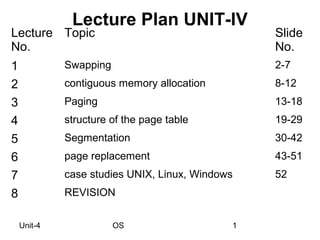The document outlines a lecture plan on memory management concepts in operating systems, including topics such as swapping, paging, segmentation, and various page replacement algorithms. It details the mechanisms for memory allocation, fragmentation, demand paging, and architecture specifics like base and limit registers as well as page tables. Additionally, it covers practical implementations in operating systems such as Unix, Linux, and Windows, including their strategies for managing memory effectively.



















































